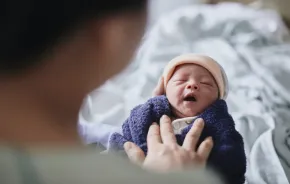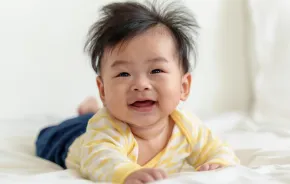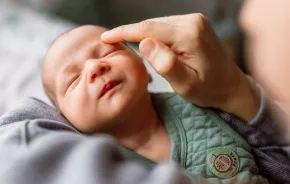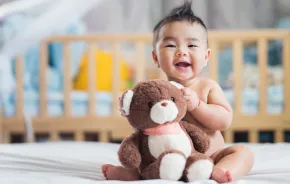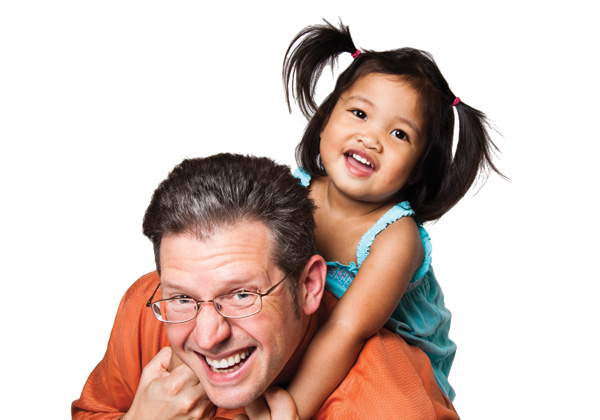 At first glance, Christina Kindt of Tacoma looks like any other first-time expectant mom, with a burgeoning baby bump, a glow of excitement and a mile-long prenatal to-do list.
At first glance, Christina Kindt of Tacoma looks like any other first-time expectant mom, with a burgeoning baby bump, a glow of excitement and a mile-long prenatal to-do list.
That is, until her three other children tumble into view. Although Christina and her husband, Kevin, are expecting their first biological child this August, they’re already parents to three: 5-year-old Elizabeth and 3-year-old Natalie, both adopted as infants from foster care, and a 1-year-old boy (she asked that his name be withheld), whose adoption from foster care is still in progress.
Though not the typical family, the Kindts are far from alone. According to the Evan B. Donaldson Adoption Institute, 2 percent of American children are adopted. That means adoption — with numbers that large — touches most families, schools and communities across the country.
Modern adoptive parents and adoptees won’t encounter many of the old stigmas and biases that used to besiege adoptions. Not long ago, “You’re adopted!” was the ultimate childhood insult, birth mothers were shamed into hiding the pregnancy and lying about the birth, and adoptive parents kept the matter a closely guarded family secret.
After being shrouded in silence and secrecy for most of its history, adoption is coming out of the shadows, becoming more mainstream and more open, according to Adam Pertman, author of Adoption Nation: How the Adoption Revolution is Transforming our Families — and America.
But would-be adoptive parents still face challenges, including choosing which type of adoption to pursue, figuring out how to pay mounting fees and navigating the exploding world of online adoption information.
Those who want to adopt internationally face tightened regulations and longer waiting periods, while those adopting domestically may have a harder time finding a Caucasian newborn: There are fewer available for adoption today than in decades past; only 1 percent of never-married white women in the U.S. relinquish their babies for adoption today, down from 20 percent in the early 1970s.
One thing is clear: Although every adoption journey is unique, adoption is becoming viewed as less unusual — and is more accepted — than ever before.
Opening doors
Because states are not required to record the number of private, domestic adoptions that take place within their purview, it’s hard to pinpoint just how many children are adopted in the U.S. each year. In 1992, the last year this type of data was compiled, the Adoption Institute reported that nearly 127,000 children were adopted in the U.S., including those adopted domestically, internationally, out of foster care and by stepparents (which account for 42 percent of all domestic adoptions).
Based on U.S. Census Bureau data, the Adoption Institute reports that there were 1.5 million adopted children in the U.S. in 2001; Pertman estimates that today, the number to be close to 7 million.
There’s likely an adoptee — or several — in your neighborhood or your child’s school. The Adoption Institute’s 1997 survey (the most recent one available) found that nearly 60 percent of Americans have a personal connection to adoption: They know someone who has been adopted, were themselves adopted as a child, or have placed their child with an adoptive family. And because so many adoptions have been veiled in secrecy, the real figure is likely much higher, since many families kept adoptions hidden, and many adoptees didn’t know they were adopted.
Those types of secrets are fading away. Today, there’s a trend toward greater openness in both domestic and international adoptions, says Judy M. Miller, an Indianapolis-based adoption support specialist, author of the e-guide What to Expect from Your Adopted Tween and mom to four children, including three who were adopted internationally.
Only 5 percent of modern adoptions are “closed adoptions,” in which the birth parents and adoptive parents have no contact and birth records are sealed, and 95 percent of agencies offer open adoptions, which allow for ongoing contact between the adoptive family and the birth parents.
That’s good news for everyone touched by adoption, says Miller. Adoption stirs up a swirl of emotions for the adoptee, including grief and loss, and adopted children eventually need to process the loss of their birth family, she says. Completely closed adoptions can stifle this healing process.
“When you don’t talk about adoption, there’s a veil of shame. People feel shame at not knowing where they came from. They want to dig deeper, and they can’t.”
By contrast, research from the Adoption Institute shows that open adoptions are associated with greater satisfaction with the adoption process for all participants — adoptive parents, adoptees and birth parents. Birth mothers who have ongoing contact with their children through open adoption experience less grief and greater peace of mind. And adoptees have access to their biological families and medical histories.
In international adoptions, ongoing contact between birth parents and adopted children can be harder to arrange, due to logistics, language barriers, and a host of legal and other complications.
But those, too, are slowly giving way. When Bothell couple Lacey Yantis and Scott Blank traveled to Ethiopia earlier this year to adopt their son Ermias, 1, they met his birth mother and learned that the date listed on his birth paperwork is wrong — he was born a month earlier. (This type of inaccuracy is not uncommon in international adoptions, says Yantis.)
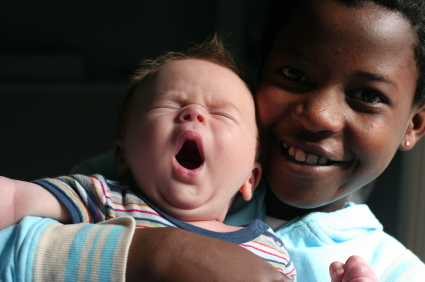 Families without borders
Families without borders
International adoption can be a good option for families seeking an infant, such as Yantis and Blank. (Nearly half of the children adopted internationally are infants, and 90 percent are younger than 5, according to the Adoption Institute.) The couple had always known that they would adopt internationally, even before the arrival of their two biological children, Kailey, 6, and Maddyn, 3.
Their Ethiopian adoption infused their family with a new culture and new community ties — they are now involved with Seattle’s Ethiopian Community Center and the literacy organization Ethiopia Reads — and enabled Yantis, Blank and their kids to forge a lifelong bond with a country half a world away. Although not without its ups and downs, their adoption has been a dream come true, says Yantis.
But those who share their dream of international adoption face a number of hurdles. The first challenge is choosing an adoption site from a dwindling list of countries open to U.S. adoptions. Under tighter regulations, the number of international adoptions appears to be tapering off; after reaching a historic high of 22,884 children in 2004, the number fell to just 12,753 in 2009.
Russia, one of the top countries of origin for American parents adopting internationally, is now closed to prospective parents in the U.S. Guatemala, Haiti, Rwanda and Vietnam are also on the “closed” list.
“Ethiopia has cut down international adoptions by 80 percent, and the wait to adopt a child from the non-special-needs program in China is at least five years,” says Lori Ingber, Ph.D., president and founder of Parent Match, a national database that offers interactive search tools designed for U.S. adoption professionals.
The waiting game adds to the mounting costs involved in adopting internationally as attorney and agency fees pile up over the course of months and years, says Ingber, who adopted two of her four children internationally. The Adoption Institute reports that parents adopting internationally can expect costs mounting to as much as $25,000 for visas, immigration documents, agency costs and program fees charged by the home country.
Yantis places her family’s adoption fees between $25,000 and $30,000 — a total that doesn’t include travel to Ethiopia or lodging and living expenses during their three-week stay. Adoptive parents traveling for international adoption also face costs related to time off work and child care for the children staying at home during the trip.
Domestic adoptions
While waiting times for some international adoptions can stretch out for years, domestic adoptions can be relatively swift. According to Adoptive Families magazine, 34 percent of U.S. parents adopting a newborn domestically were matched with a child within three months; 19 percent brought their baby home within four to six months. Couples who choose to adopt domestically have several options: private (or “independent”) adoptions through an attorney or an adoption facilitator, adopting through an agency, or adopting through the foster care system (sometimes called “public adoption”).
How can prospective parents choose which type of domestic adoption to pursue? One factor is cost. The Adoption Institute pegs domestic adoption costs for agency and private adoptions at anywhere from $4,000 to $30,000. It’s a wide range that includes costs for home studies, post-adoption supervision and court fees.
Ultimately, parents’ final costs depend on each individual state’s adoption laws, which can vary widely. In some states, adoptive parents aren’t allowed to buy so much as a lollipop for birth mothers; in others, they can pay her rent and medical expenses, notes Ingber.
“If you’re paying someone’s rent, those are huge expenses. You need to go in with your eyes open and know what you’re getting into.” (In Washington state, birth parents cannot accept financial compensation or anything of value in return for relinquishing a child for adoption.)
But costs for domestic adoptions often fall well below the $30,000 mark. Patty Lazarus of Mercer Island, author of March Into My Heart: A Memoir of Mothers, Daughters, and Adoption, says costs for the private adoption of her newborn daughter, Sophie, now 11, were around $15,000 — less than she spent on fertility treatments (such as IVF) before choosing to pursue adoption.
Another factor is the age of the prospective adoptee. The Kindt family’s experience notwithstanding, newborn adoptions through the foster care system are relatively rare — only 2 percent of children adopted through the public system are newborns, according to the Adoption Institute.
Thanks in part to federal financial incentives enacted during the Clinton administration, foster care adoptions are on the rise. Between 1995 and 1998, they increased 40 percent to 36,000; by 2008, 55,000 children were adopted from foster care.
The perception that foster care adoptions are all older children with behavior problems is untrue, says Kindt. “You can absolutely adopt an infant, and it can be very quick.” There’s also little or no cost to the adopting family; there are no agency fees, legal fees are often minimal and reimbursed by the state, and parents can claim the adoption tax credit (as can parents adopting internationally or through an agency or attorney).
Building a family
The first step for couples considering adoption is to talk to others who have adopted, advises Ingber. “Ask them which agency they used, or which attorney. Ask them about their experience. Talk to as many people as you can.” Potential adoptive parents want to choose an adoption attorney or facilitator with significant experience with adoptions, she notes — not a friend of a friend who practices law but specializes in DUIs or divorces.
“If you choose to work with an agency, make sure it’s an agency that shares feedback from other parents,” says Miller. She researched 70 — yes, 70 — agencies before choosing one that offered to share feedback from past clients, both satisfied customers and unhappy ones, as well. A good agency also provides support for both the adoptive family and the birth mother, before and after the adoption, Miller says.
Take advantage of the Internet’s expansive power for research, referrals, information and support; many agencies now have Facebook pages where prospective parents can ask questions, share victories and support each other through tough days. But don’t get swamped with information overload, advises Miller. When staring at a screen starts to feel overwhelming, consider a phone call or a face-to-face meeting with an adoption professional, which can be quicker than sifting through millions of pages of adoption information available online.
Most importantly, parents should follow their heart to build a family that’s uniquely their own. The Kindts may not be a cookie-cutter clan, but that doesn’t bother their happy children in the least. Instead, Elizabeth is puzzling over her brother’s approaching birth.
“Adoption is so normal to her that she’s trying to figure out why this baby doesn’t need to be adopted,” says Christina. “One day, she figured it out, though, and told everyone ‘Mommy has a baby in her tummy. And he’s already adopted!’”
Malia Jacobson is a nationally published parenting journalist and mom of three.
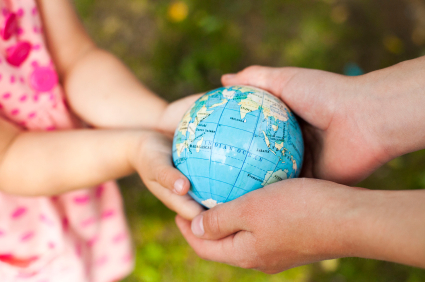 Adoption Support
Adoption Support
Support Groups
World Association for Children and Parents
Adoption Referral and Information Service
Washington Adoption Reunion Movement
Research and Resources
Evan B. Donaldson Adoption Institute
Intercountry Adoption, Bureau of Consular Affairs, U.S. Department of State
Agencies
Amara Parenting
danielle@amaraparenting.org
Open Adoption & Family Services
Washington Adoption Resource Exchange








